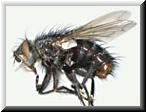Reared specimens examined. Panzeria ampelus (Walker), dates given are for field collection of bertha armyworm larvae: Manitoba, Kenville (1 specimen, 17.viii.1972), Roblin (1 specimen, viii.1972), Gilbert Plains (1 specimen, viii.1972), Birtle (1 specimen, viii.1974), and Bowsman (1 specimen, 30.vii.1980); Alberta, Lethbridge (1 specimen, 1979) (UMW); Saskatchewan, Aylsham (1 specimen, 1948), Codette (1 specimen, 1948), and Biggar (3 specimens, 5-19.viii.1988) (SRCS).
Panzeria is a large Holarctic genus with 28 species recorded in the Nearctic region (Wood 1987). One species, Panzeria ampelus (Walker), is an infrequent but widespread parasitoid of bertha armyworm in the prairie provinces of Canada (Turnock 1984, 1988; Wylie 1977b; Wylie and Bucher 1977), causing less than 1% parasitism (Wylie and Bucher 1977). It is often cited in the literature in combination with the generic name Ernestia Robineau-Desvoidy or Mericia Robineau-Desvoidy. Keys to the identification of Nearctic Panzeria species have been published by Tothill (1921, as Ernestia) and Brooks (1943, as several genera). As mentioned under Eurithia above, E. consobrina is a Palearctic tachinid of Panzeria-like appearance that has been introduced into Canada for control of bertha armyworm.
Recognition. Panzeria and Eurithia are the only representatives of the Tachininae to parasitize bertha armyworm. As is typical of the subfamily, the prosternum is bare (as in Dexiinae, to which Athrycia belongs). These two genera can be characterized together as possessing the following additional characters: body dark-coloured and robust, eye haired, facial ridge with hairs confined to area immediately above vibrissa, parafacial bare (few exceptions), lower margin of face visible in profile, palpus normal (not reduced), posterior margin of hind coxa bare, middle basal seta of postpronotum displaced anterolaterally and forming a triangle with outer and inner basal setae, scutellum with 3 or more pairs of setae in addition to a pair of crossed apicals, and male with syntergite 7+8 expanded and shiny yellow, red or black (concolorous with epandrium but often contrasting with terga 1-5).
The genus Eurithia is not recognized in the Nearctic region and is separated from Panzeria in the Palearctic region by subtle characters; these taxa should probably not be recognized as generically distinct (in which case the Panzeria would have priority). Among Nearctic species, specimens of P. ampelus and E. consobrina are most easily distinguished from other Panzeria species using characters in the male:
P. ampelus - syntergite 7+8 and epandrium shiny yellow or red, base of cerci bifid.
E. consobrina - base of cerci with long, almost perfectly triangular keel (larger than in any of the native Panzeria species, cf. with figures in Brooks 1943).
The immature stages of P. ampelus were described and illustrated by Tothill (1922) and Arthur and Powell (1990); the puparium was described and illustrated by Greene (1922).
Biology. Adult females of P. ampelus attach their eggs to foliage in the vicinity of hosts (Tothill 1922). The eggs hatch in minutes and the larvae wait in a vertical position for a passing host, to which they cling and then quickly penetrate (Tothill 1922, Wylie 1977b). Later instars of bertha armyworm are preferred. Larvae of the parasitoid develop for 2-3 weeks within the host, emerge and form puparia, and pass the winter in the pupal stage (Wylie 1977b). In the northeastern United States there are usually two generations per year with adult activity from late April to early June, and from mid July to August (Schaffner and Griswold 1934). In New Brunswick adults are active into September (Tothill 1922). The species is apparently univoltine in New Brunswick (Tothill 1922, Morris 1976) and bivoltine in western Canada (Wylie 1977b). In western Canada only the second generation attacks bertha armyworm (in July and August), the first generation appearing too early in the season to do so; even in the second generation bertha armyworm seems not to be the preferred host because parasitoid survival in that host is low (Wylie 1977b). Generally only one parasitoid develops in each host (Schaffner and Griswold 1934, Wylie 1977b).
Panzeria ampelus is an important parasitoid of the fall webworm, Hyphantria cunea (Drury), and has been introduced into Europe for the biological control of that pest. Other hosts in North America include a few species of Arctiidae, Lasiocampidae and Notodontidae (Arnaud 1978, as Mericia ampelus).
Distribution. Sabrosky and Arnaud (1965) record the distribution of P. ampelus (as Mericia ampelus) as: British Columbia to Nova Scotia, south to California and Maryland, also Georgia.


